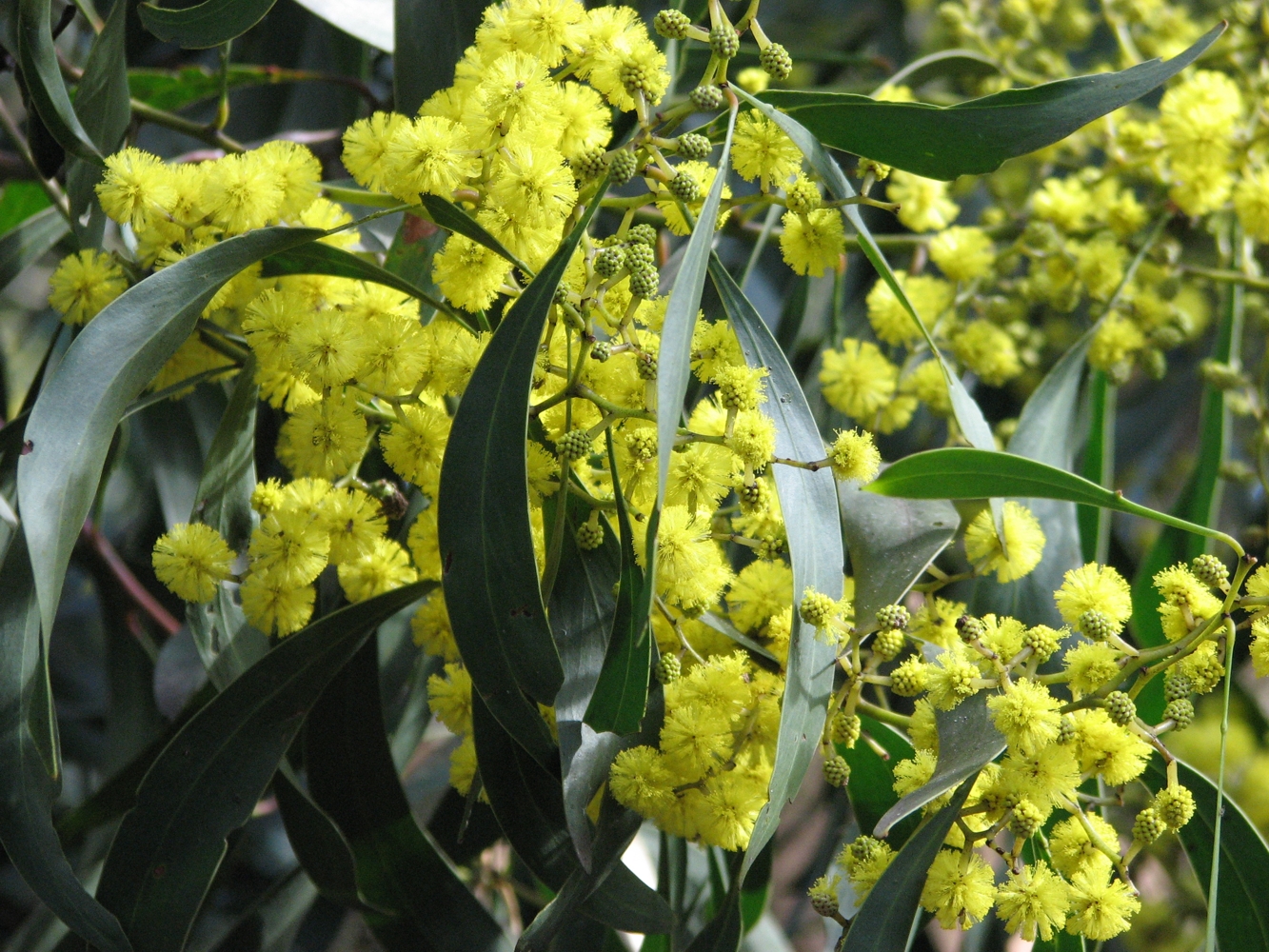- Acacia pycnantha
image_width = 240px
regnum =Plantae
divisio = Angiosperm
classis =Dicotyledon
ordo =Fabales
familia =Mimosaceae
subfamilia =Mimosoideae
genus = "Acacia "
species = "A. pycnantha"
binomial = "Acacia pycnantha"
binomial_authority = Benth.Golden Wattle ("Acacia pycnantha") is
Australia 'sfloral emblem . It is a small tree which flowers in late winter and spring, producing a mass of fragrant, fluffy, golden flowers.Description
The species grows to between 2 and 8 metres in height with generally smooth, dark brown to grey bark. The mature trees do not have true leaves but have long,
sickle -shapedphyllode s. These are shiny and dark green and are between 8 and 20 cm long and 0.5 to 3.5 cm wide. The rounded inflorescences are bright yellow and occur in axillary racemes or terminal panicles in groupings of between 4 and 23. These are followed by flattish, straight or slightly curved pods which are 5 to 14 cm long and 0.5 to 0.8 cm wide.cite book|author=Costermans, L.| title=Native Trees and Shrubs of South-eastern Australia |publisher=Rigby|location=Australia | year=1981 | id=ISBN 072701403x] cite web |url= http://plantnet.rbgsyd.nsw.gov.au/cgi-bin/NSWfl.pl?page=nswfl&lvl=sp&name=Acacia~pycnantha |title= Acacia pycnantha |accessdate=2007-08-28 |format= |work= PlantNET - New South Wales Flora Online ]Taxonomy
"Acacia pycnantha" was first formally described by botanist
George Bentham in the "London Journal of Botany " in 1842. Thetype specimen was collected by the explorerThomas Mitchell from the interior ofNew South Wales . APNI|name =Acacia pycnantha Benth.|id = 14993 ] The specific epithet "pycnantha" is derived from the Greek words "pyknos" (dense) and "anthos" (flowers), a reference to the dense cluster of flowers that make up the globular inflorescences. cite web | author=Boden, Anne| year=1985| title=Golden Wattle: Floral Emblem of Australia | format=http | work=Australian National Botanic Gardens | url=http://www.anbg.gov.au/emblems/aust.emblem.html | accessmonthday=28 August | accessyear=2007]Synonyms include:
*"Acacia falcinella" Meisn.
*"Acacia petiolaris" Lehm.
*"Acacia pycnantha" var. "petiolaris" H.Vilm.
*"Acacia pycnantha" Benth. var. "pycnantha"
*"Acacia westonii" Maiden
*"Racosperma pycnanthum" (Benth.) PedleyDistribution
Golden Wattle occurs in south-eastern Australia from
South Australia ’s southernEyre Peninsula into western Victoria and northwards into inland areas of southern New South Wales and theAustralian Capital Territory . It is found in the understorey of openeucalypt forests on dry, shallow soils. It is naturalised in areas within all the southern states of Australia as well asSouth Africa andCalifornia .Uses
Golden Wattle has been grown in temperate regions around the world for the
tannin in its bark, which provides the highest yield of all the wattles. The scented flowers have been utilised forperfume making.Cultivation
Golden Wattle is cultivated in Australia and was introduced to the northern hemisphere in the mid 1800s. Although it is short lived, it is widely grown for its bright yellow, fragrant flowers. The species has a degree of frost tolerance and is adaptable to a wide range of soil conditions, however it prefers good drainage. Propagation is from seed which has been pre-soaked in hot water to soften the hard seed coating.
ymbolic references
Although wattles, and in particular the Golden Wattle, have been the informal floral emblem of Australia for many years, it was not until Australia’s bicentenary in 1988 that the Golden Wattle was formally adopted as the Floral Emblem of Australia. The date of gazettal was
September 1 which was marked by a ceremony at theAustralian National Botanic Gardens which included the planting of a Golden Wattle byHazel Hawke , the Prime Minister’s wife. In 1992,September 1 was formally declared as "National Wattle Day".The Australian Coat of Arms includes a wreath of wattle, however this does not accurately represent a Golden Wattle. Similarly, the
green and gold colours used by Australian international sporting teams were inspired by the colours of wattles in general, rather than the Golden Wattle specifically.The species was depicted on a 2 shilling stamp captioned "wattle" as part of a 1959-60 Australian stamp set featuring Australian native flowers. In 1970 a 5c stamp labelled "Golden Wattle" was issued to complement an earlier set depicting the floral emblems of Australia. To mark
Australia Day in 1990 a 41c stamp labelled "Acacia pycnantha" was issued. The Golden Wattle inspired the design and decoration of theOrder of Australia which was established in 1975.ee also
*
List of flora on stamps of Australia References
Wikimedia Foundation. 2010.

